NCAC NEWS(Vol.7,No.4)
Results of Comparative Test of Child Safety Seats
In Japan, the usage of child safety seats when driving with a child in the car is extremely low, compared to the use of adult seat belts. (The rate of use is only 7.7% according to the Japan Automobile Federation (JAF)). We tested 6 brands of child safety seat sold by 6 companies intended for use by small children between the ages of 4 months and 4 years, and priced between 26,800[Yen] and 29,900[Yen].
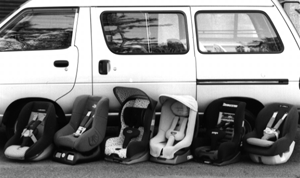
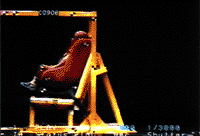
![]()
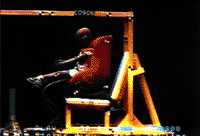
![]()
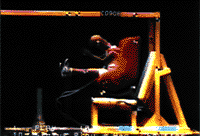
Safety
Crash tests simulating a 50km/h head-on crash showed that there was no problem in the failure strength of the buckle, the amount of shock and the amount the dummy moved immediately after the impact. However, in the case of one brand, the structure of the child safety seat is such that the back plate opens up under impact, the back plate opened up and pressed into the back of the dummy. Furthermore, the belt remained tensely stretched out, which made the buckle difficult to undo.
With another brand, the metal fitting to insert into the chest guard deformed under impact, and became exposed. However, this had no effect on the (dummy) child. With two other brands, the buckle's insertion fittings deformed somewhat.
Performance
All six brands had a cushion material for the back and especially for the head in order to soften the shock. However, there was a difference in the size (scope) and thickness. Our test assumed a head-on crash, and so we could not investigate the effects of differences in the thickness of the cushion material.
The seat back, which is supposed to hold the child while riding in the car, was sufficiently large in all brands.
As for the material for the seat cover, there was some difference in terms of durability, strength of dyed color, and so forth.
Usability, labeling, etc.
The monitors evaluated that the brand that was heavy with a rounded bottom was hard to carry, tended to become unstable, and was difficult to install.
In response to the enforcement of the Product Liability Law, the makers have added more labels for danger, warnings, prohibitions, precautions, etc., both in words and graphic illustrations. However, because these cautions were written in various places in the handling instructions, they were often difficult to understand.
Advice to consumers
Points to remember when making a purchase
- Choose the type of child safety seat from which your child will not be able to get out easily on his or her own.
- Check that the child safety seat is suitable for the car in which you intend to install and use it.
- Choose a type which is very stable.
- Check the comfort of the seat by pressing it.
- Choose the type whose cover is easy to put on and take off, with strong stitching.
- Check that the product has the JIS (Japan Industrial Standard) mark (fig1) and the approval mark of the Ministry of Transport (fig2) attached.

Precautions on usage
- Make sure that you read the handling instructions carefully. Read not only about the normal method of use, but also the explanations on how to deal with an emergency situation, the various cautions and warnings, etc.
- Always install in the proper place.
- Install the child safety seat firmly on the seat.
- Carefully inspect the belt often.
- While driving, check that the child has not gotten out of the seat. As the child grows older, he or she may want to get out of the child safety seat, or may try to release the buckle.
- Do not continue to use the child safety seat after it has suffered a severe impact because the styrofoam materials, etc., inside it do not recover and so may not be able to absorb the shock adequately the next time. This should be examined very closely when purchasing a second-hand child safety seat.
Results of Product Test for Air Cleaner
In Japan, huge quantities of cedar pollen blanket the country between March and May of each year, the season of pollinosis (pollen allergy). More and more people are wanting to remove all the dust, pollen and other allergic substances, as well as odor, that float in the room. Air cleaner is therefore attracting great interest now. However, consumer information centers in a number of communities have been receiving complaints such as "the air cleaner that I bought doesn't work at all," and so forth. We therefore tested 7 brands of air cleaner sold by 6 companies, both the forced circulation type (equipped with a fan) and the non-forced circulation type, for their ability to collect dust, remove odor, etc.
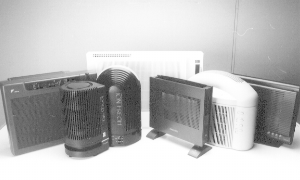
Performance
We tested the equipment's ability to collect dust and remove the odor of burning cigarette smoke. We found that there were significant differences among brands of the forced circulation type. With the non-forced circulation type, the equipment simply removed dust from the area gradually, and the performance was far lower that of the forced circulation type. Thus, consumers cannot expect practical results from the non-forced circulation type in very dusty or contaminated places. Next, we investigated the removal of ammonia gas, which is the main component of the offensive odor of cigarettes. The non-forced circulation type brands had no appreciable effect. As for the forced circulation types, while there were some differences among the brands, some brands were effective in removing the odor. However, even these could not remove the odor to the point where the order could not be detected.
Safety
We investigated the generation of ozone because when there is a high concentration of ozone, it can damage the human body, especially the breathing organs. All the brands generated a small quantity of ozone, but the concentration within the room was a very small quantity in all cases, which is not sufficient to have an adverse impact on the human body.
Labeling
Each brand had information on the label concerning the applicable room area, but the actual performance of nearly all of the brands tested was inadequate for the indicated room area. In particular, the non-forced circulation brands were not adequate even for a 6-tatami room (one tatami normally measures about 90cm by 180cm, or 1.62 square meters). The performance of this type is thus far below the indicated amount. Also, with regard to the dust collection and odor-removing capabilities, the information in the catalog was frequently misleading for consumers.
Advice to consumers
When you purchase an air cleaner, choose the type carefully, because there are large differences in the performance depending upon the type as well as the brand. In making your selection, use the results of this test as a guideline, and choose the type which meets your specific needs. Also, in terms of cautions in using the equipment, the air cleaner that we tested could not remove gas emitted from an open stove; the filter should be changed frequently, and be aware that the area around the air cleaners to get more dirty. Take care of these points.
Report on Meal Delivery Service for Elderly Persons - Outline of the Service and Results of Questionnaire to Users
Japanese society is graying at an unprecedented rate. As of May 1995, therewere 18,210,000 persons above 65 years of age, or 14.5% of the population. By households, the number of elderly persons living alone and the number of households consisting of only an elderly couple are increasing.
Public services for the elderly must urgently be upgraded, and such services in the private sector must be developed, both in quantity and quality. The meal delivery services for the elderly (hereafter called "meal delivery service" ) which we investigated this time are one type of such service, and the demand for this kind of service is expected to increase in the coming years.
Meal delivery services fall into the following three categories: (1) A service provided by a business enterprise in the private sector for profit, (2) a service provided for welfare purposes, by local governments and nonprofit groups established to carry out welfare work, and (3) a service which is run with the aim of mutual aid by consumer cooperatives and/or volunteer groups.
The purpose of all of these meal delivery services is to support the daily living of elderly persons who have difficulties in cooking. In addition, the services in categories (2) and (3) seek to ease the sense of isolation of the elderly.
The services provided by 8 companies in the private sector are as follows:
- Anyone can use the service unlike the services in which local government is involved.
- Seven companies deliver foods that can be eaten immediately after delivery, while one company delivers cooked food in retort packs through a chilled delivery service.
- All providers consider nutritional balance, salt and other factors to suit the needs of elderly persons. Some providers prepare diet meals and special meals for diabetics.
- 6 companies use recoverable containers, while one company uses disposable containers as well as utensils that are collected. The company which delivers country-wide uses vacuum packs.
- Four out of eight companies operate 365 days a year with no holidays.
- There is a big difference in the cost; some companies charge 400[Yen] to 500[Yen] for one meal, while others charge between 600[Yen] to 700[Yen], or even more than 1,000[Yen].
- Seven companies allow cancellation in the middle(of the set term) unconditionally. One company allows such cancellation on a conditional basis. The main findings of the survey of users are as follows (319 men and women who use food delivery services and who are over sixty years of age responded.)
- As for the reason for using the service, 43.6% said, "Because I want to eat nutritionally balanced meals" (multiple answers).
- I am satisfied with the flavor, but I wouldn't consider the meals "delicious."
- In terms of the menu and cooking method, most people said, "It is good as is," but 20% of the respondents were dissatisfied with the service.
- 80% of the respondents answered, "I think it's cheap considering the materials cost and labor cost, and the price is resonable."
- 10% of the respondents said, "I am dissatisfied that there are no deliveries on national holidays."
- 80% of the respondents would like to "make use of meal delivery services in the future as well."
List of Product Tests in FY 1995
NCAC carried out comparative tests for 15 product items during FY 1995. The results and findings from these product tests were announced in a monthly magazine, "Tashikana-Me"(Critical Eyes). We will introduce the items that were announced for your reference.
| date of release | tested products |
|---|---|
| 1995. Apr. | Food enriched or added with DHA |
| May | Confectionery products that promote their functional purpose - candies that claimed to have good effects on the teeth and low calories |
| Jun. | Air conditioner - cooling function and dehumidifying function
Water purifying equipment |
| Jul. | White shirts with a "no-iron" claim |
| Aug. | Fully automatic washer with spray and rinse Electronic blood pressure gauge for home use |
| Sep. | Tuna for eating fresh (raw) A detergent "which can be used to clean many clothes designated for dry cleaning " |
| Oct. | Air conditioner - About its overall functions with emphasis on its heating functions |
| Nov. | Futon mats and futon mat covers that claim the ability to prevent ticks and lice, etc. |
| Dec. | Portable telephones & PHS (personal handy phone system) |
| 1996. Jan. | Chlorella - Chlorella as a health food, and soft drinks containing chlorella |
| Feb. | Child safety seat |
| Mar. | Air cleaner |
